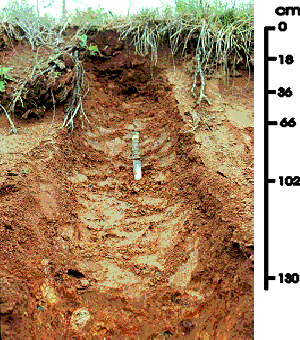Profile Description
- 0-18 cm; very dark brown (10YR2/2) silty clay loam; moderate fine subangular blocky structure; hard, friable, slightly sticky, slightly plastic, many roots; 10% concretions; pH=6.0; clear smooth boundary
- 18-36 cm; dark brown (10YR3/3) silty clay loam; moderate medium subangular blocky structure; hard, friable, slightly sticky, plastic; many roots; few clay film and 5% concretions; pH=5.8; clear smooth boundary
- 36-66 cm; brown (7.5YR4/4) silty clay; moderate medium subangular blocky structure; hard, friable, sticky and plastic; many roots; common thin clay films; pH=5.3; gradual smooth boundary
- 66-102 cm; brown (7.5YR4/4) silty clay; common mottles (7.5YR5/2);moderate medium and fine subangular blocky structure; hard, friable, sticky and plastic; few roots; many thin clay films; pH=5.3; clear irregular boundary
- 102-130+ cm; yellowish brown (10YR5/6) clay; many gray (10YR5/1) and common reddish brown (5YR4/4) mottles; moderate coarse breaking to fine angular blocky structure; very hard, firm, very sticky and plastic; few roots; many clay films; pH=5.6; clear wavy boundary
